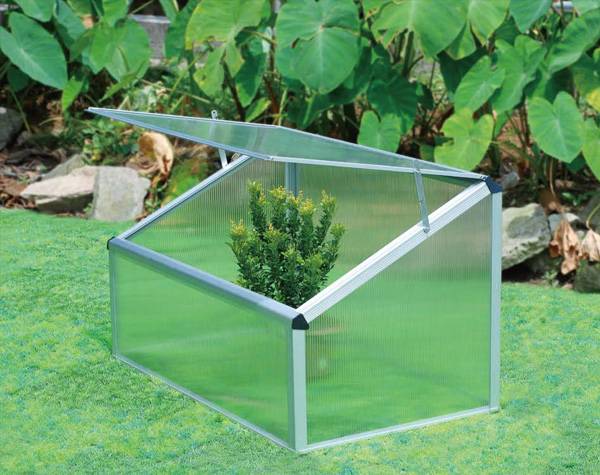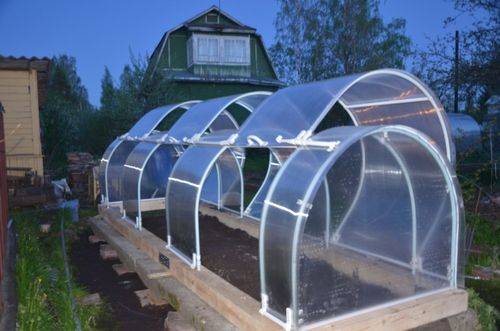Content
If you want to grow early vegetables or herbs in your garden, you will have to take care of temporarily sheltering the plants from the cool of the night. A simple solution to the problem is to build a greenhouse. There are many types of shelters, but a polycarbonate greenhouse with an opening top is most often liked by vegetable growers. You don’t need to allocate a lot of space for such a mini-greenhouse, and the building will cost several times less.
Why are there opening doors in a greenhouse?
The greenhouse is designed for growing early greens, seedlings and low plants. A disposable shelter is usually made of film or non-woven fabric, but the permanent structure is sheathed with polycarbonate. The sun's rays pass through the transparent walls, warming the soil and plants. But the heat comes back out of the shelter very slowly. It accumulates in the soil and warms the plants from evening until morning, when the sun hides behind the horizon.
Most often, a greenhouse or greenhouse made of polycarbonate is made from the top.Why is this necessary, since the shelter is designed to retain heat? The fact is that accumulated heat does not always benefit plants. In extreme heat, the temperature inside the greenhouse rises to a critical level. Moisture is lost from the leaves and stems of plants. Due to dehydration, the crop turns yellow and then disappears. To save plants in hot weather, the doors on the roof of the greenhouse or greenhouse open. Ventilation helps normalize the optimal air temperature.
The second purpose of the opening doors is to provide free access to plants.
Typically, when making a polycarbonate greenhouse, the following dimensions are adhered to:
- structure length – 1.5-4 m;
- the width of the product with one opening segment is 1-1.5 m, with two opening doors – 2-3 m;
- height – from 1 to 1.5 m.
Now imagine that you have a greenhouse 1 m high. Polycarbonate is not a film. It cannot simply be lifted to water or feed plants. All these problems of plant care are solved when the top sash opens. A person gets convenient access to plants. The opening top allows you to make even wide polycarbonate greenhouses. To access plants in such shelters, several doors are installed on both sides.
Types of polycarbonate shelters with opening top
According to the shape of the roof, greenhouses and greenhouses with an opening top are divided into the following types:
- For lining a greenhouse with arched roof polycarbonate is the best, one might say, the only material. Transparent sheets are elastic. They can be easily shaped into a semicircular arch. The light weight of the sheet allows one person to work with polycarbonate. The high strength of the material can withstand snow loads, but thanks to its semicircular shape, precipitation does not accumulate on the roof. The advantage of the arched design is that condensation flows down the walls, and it does not fall on growing plantings. The disadvantage of a semicircular roof is the impossibility of growing tall plants. This is due to the impossibility of installing ventilation windows on the long sides of the greenhouse.
- A polycarbonate greenhouse with a roof called a “droplet”, is a subtype of arched design. The frame has a streamlined shape. Each slope segment converges to the top, where a ridge is formed. The shape of the roof is very convenient in terms of low precipitation accumulation.
- Greenhouse with a gable roof resistant to heavy loads. The design makes it possible to produce convenient rectangular-shaped opening top doors. Gable roofs made of polycarbonate are installed even on stationary greenhouses. In such shelters you can grow crops of any height. The only drawback is the high cost of the structure. This is due to the complexity of manufacturing a gable roof.
- Greenhouse with pitched roof resembles a box or chest, the lid of which opens upward. The polycarbonate structure is made free-standing in the garden or adjacent to the house. The only advantage of the shelter is its ease of manufacture. The sun's rays penetrate poorly, plants receive little light and develop poorly.At any slope, a pitched roof will collect a lot of precipitation, which increases the pressure on the polycarbonate. In winter, snow accumulations must be constantly cleared from a pitched roof, otherwise the polycarbonate will not withstand the heavy weight and will fail.
- Dome shape A greenhouse or greenhouse consists of triangular segments. Each element, sheathed with polycarbonate, creates refraction of light rays, which ensures its dispersion inside the greenhouse. The shutters can be made so that the roof is completely, if necessary, open or partially open.
A shelter with any roof shape can be made independently and sheathed with polycarbonate. Opening sashes are made with hinges or a factory-made mechanism is purchased. If desired, a ready-made polycarbonate greenhouse with an opening top can be purchased at the store. Its frame is quickly assembled according to the attached diagram and sheathed with polycarbonate.
The most popular among vegetable growers are the following factory-made models:
- Name "breadbox" the greenhouse acquired due to its shape. The arched structure is made with one sliding sash upwards. Some models are sometimes equipped with two opening doors. The shape and principle of opening the door are made like a bread box.
- Shelter model called "butterfly" the shape resembles a “breadbox”. The same arched polycarbonate structure, only the doors do not move, but open to the sides. When raised, the roof resembles the wings of a butterfly. The video shows instructions for installing a “butterfly” greenhouse:
- A polycarbonate greenhouse in the shape of an opening chest is called "Belgian". When closed, the structure is a rectangular structure with a pitched roof. If necessary, the flap is simply opened upward.
Most often, the frame of factory greenhouses is made of aluminum elements. The finished structure is mobile and, if necessary, can be disassembled for storage.
Advantages of polycarbonate greenhouses with opening doors
Buying or making your own polycarbonate greenhouse will cost a little more than simply installing arches in the garden bed and stretching the film. However, this has its advantages:
- The compactness and mobility of the product allows you to move it to any place. The materials used for manufacturing are lightweight, allowing the structure to be moved by two people. Thanks to its small dimensions, the greenhouse can fit in the smallest summer cottage where it is impossible to install a greenhouse.
- Polycarbonate and aluminum are inexpensive, strong and durable materials. As a result, the vegetable grower receives a cheap shelter that will serve him for many years.
- A greenhouse with opening doors allows you to use the entire usable area of the garden bed. Moreover, the vegetable grower gets convenient access to the plants, which makes caring for them easier.
If the arguments for the usefulness of a polycarbonate shelter are convincing, it is time to choose the optimal installation location.
Where is the best place to put a greenhouse?
Small polycarbonate shelters are most often in demand in small summer cottages. In large yards it is more profitable to install a greenhouse. Returning to small areas, it is worth noting that it is usually not necessary to choose according to all the rules where to install the greenhouse. The owner is content with the minimum free space.
When there is no desire to install a stationary greenhouse on a large suburban area, then the choice of location for a greenhouse is approached competently:
- The optimal location for installing a greenhouse is the southern or eastern side of the site. Here the plants will receive a lot of sunlight and warmth. It is better not to install a polycarbonate shelter on the north or west side of the yard. The work will be in vain, and the vegetable grower will not see a good harvest.
- Maximum illumination is an important factor in choosing a location. It is not advisable to place a polycarbonate shelter under trees or near tall structures that will cast shadows.
- To keep the greenhouse warm longer, it is placed in a place protected from cold winds. It is advisable that there is a fence or any other structure as close as possible to the north side.
After choosing the optimal location on your site, it is prepared for installation of a polycarbonate shelter.
Site preparation
When preparing a site, it is immediately important to pay attention to the terrain. It is optimal if it is a plain. Otherwise, the hills will have to be cleared and the holes filled. If it is not possible to choose a site on a hill or the high location of groundwater interferes, it will be necessary to organize drainage. It will drain excess water from the garden bed.
The area is cleared of any vegetation, stones and various debris. You must immediately decide whether this will be a permanent installation or a temporary one. If the greenhouse will be permanently installed in one place, it is reasonable to build a small base for it.
The procedure for making the foundation
A polycarbonate shelter is very light and does not require laying a strong foundation.When performing a permanent installation of the structure, you can make a simple base from timber or red brick.
The simplest base is made using the following technology:
- using stakes and construction cord, markings are applied to the area;
- a trench is dug to the depth and width of the bayonet shovel along the markings;
- a third of the depth of the trench is covered with sand;
- red brick is laid out with dressing, or even without mortar;
- if the foundation is made of timber, the box is pre-treated with impregnation, roofing material is fixed at the bottom and sides, and then installed in the trench;
- the gap between the brick or wooden foundation and the walls of the trench is filled with gravel.
The installed polycarbonate greenhouse, together with the foundation, is attached to pieces of reinforcement 70 cm long, driven into the ground. This will prevent the lightweight structure from tipping over in strong winds.
The procedure for assembling a store-bought polycarbonate greenhouse depends on the chosen model. Instructions and a diagram are supplied with the product. Usually all elements are connected with hardware. Homemade frames are most often welded from a tube, angle or profile. Polycarbonate fragments cut from a large sheet are fixed to the frame with special hardware with a sealing gasket. The assembled greenhouse will only need to be secured to the foundation and you can arrange the beds.
For your reference, this video shows the “Umnitsa” greenhouse with an opening top:




















